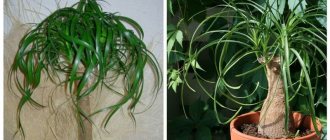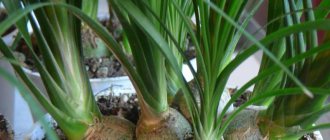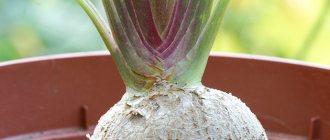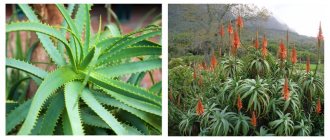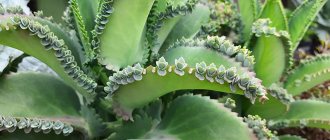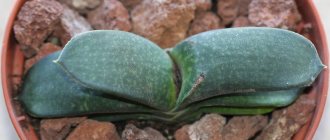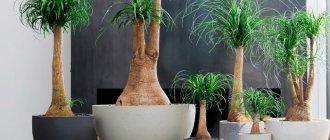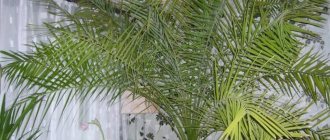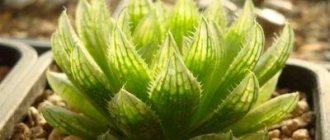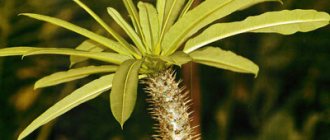What words can describe this very original-looking representative of the flora?
Cute and clumsy, stubbornly adapting to the harshest conditions around him. Alien grace hidden under a cap of dense foliage. There are many more bright epithets that can be chosen, but flower growers, lovingly, call bocarnea much simpler and more down-to-earth: ponytail, elephant foot and bottle tree. Based, of course, on external characteristics!
This unusual palm tree has a bark that resembles rough elephant skin to the touch, a shape like a pot-bellied bottle, and long, narrow, belt-like leaves that resemble a ponytail gathered in a bun.
Varieties and photos
Bocarnea was first encountered in the central regions of Mexico and immediately amazed botanists with its size - in its homeland it reaches more than 10 meters in height and more than a meter in diameter . Its leaves are so strong that local residents used them to weave baskets and hats. However, the cultivated bokarnia abruptly lost the ability to stretch to such a grandiose size and turned into a plant convenient for growing and caring for at home, unpretentious in everyday life, but without losing its other external characteristics. Belongs to the Agave family.
Below are descriptions and photos of the main varieties of bocarnea, which can be cared for at home and in the botanical garden.
Recurved (Beaucarnea recurvata)
This variety has a bizarrely curved and very powerful trunk, reminiscent of a tree with a pot-bellied bulb near the ground. This thickening stores a supply of water collected during the short rainy season and stored during a long drought. According to scientists, the plant can survive on such a supply for a whole year! However, the trunk will lose all its power. The leaves of the variety are hard and narrow, lanceolate in shape. They also help in collecting moisture. The photo below shows a bent bocarnea (recurvata):
Longleaf (Beaucarnea longifolia)
It reaches a height of 2-3 meters, the trunk-branches grow from 3 to 5. The leaves are soft, dark green, up to 2.5 meters long and up to 3 cm wide. The trunk is covered with a corky bark of gray-brown color. You can see what the longleaf variety looks like in the photo below:
Compressed (Beaucarnea stricta)
Refers to a medium-sized species. It stretches up to 10 meters in height, branches from the very base. Leaves are 50-80 cm long and 0.8-1.5 cm wide, bluish-green. The leaves grow very densely and outwardly resemble spherical “brush brushes” , the tips of which can even prick you. Dew from such leaves does not evaporate, but rolls down it to the base of the trunk. In the photo below, the bocarnea variety is compressed:
The genus includes approximately 30 varieties, but only bocarnea reflexata (nolina) grows well at home, the rest do not take root well.
Bocarnea was first encountered and described in 1803 by the French botanist Andre Michaud, traveling through the hot Mexican territory, which was scarce and lacking in water. Somewhat later, the culture was discovered in the southern states of the United States.
Common varieties of succulents of the genus Beaucarnea
As already indicated in the description, about 10 species of the genus Beaucarnea have been described so far. Not all of them are available for sale. But several varieties are common and often become the centerpiece of a houseplant collection. Let's describe them in more detail.
Beaucarnea recurvata (Beaucarnea recurvata)
This species can also often be found under the name Nolina recurvata. Probably the most common variety of bottle palm. A tree with a pronounced caudex, grows at home up to one meter and above.
Bocarnea recumata rarely blooms indoors, but if you grow it outdoors, a mature succulent will produce stems of flowers that can reach 15 feet or more in height. The stems produce clusters of small yellowish or beige flowers that open during the summer months.
Beaucarnea or Nolina graceful (Beaucarnea gracilis)
A small tree or large shrub with many thin, arching vertical stems that emerge from a large, beautiful globular woody caudex. In nature it can grow up to 5 meters in height.
The caudex is highly swollen, most of which is visible above the ground. The leaves are very narrow, 45-50 cm long. Numerous small flowers are collected in a wide panicle. Each short-stemmed flower is slightly fragrant.
Beaucarnea stricta
A tree-like plant, slightly branched at the top. It is not as popular in nurseries as its relatives. The caudex is thickened at the base with a thin trunk. The stem, as a rule, does not branch until it reaches a certain height. The total height of an adult succulent is up to 8 (sometimes 10) m, the caudex will gradually reach 3 m in diameter.
The trunk and branches are covered for a long time with the remains of many dried leaves. The leaves are gray-green or grayish-blue, straight, hard, spreading, 60-90 cm long. Cream-colored flowers are collected in inflorescences 60 cm high and 30 cm wide.
The article uses materials from plantopedia.com
Care
Lighting
Bocarnea, like a true southerner, loves the sun and warmth. Therefore, prepare for it a cozy place that is illuminated by the sun - the plant will bask under its direct rays. This is that rare case when there is no need to organize any shading for the culture. Only in the light will a characteristic thickening form at the bottom of the trunk, while in the shade it will stretch upward. Windows - facing south, southwest, southeast.
Don’t forget to turn the container with the plant toward the light once a week, alternately : one side, then the other. These manipulations will protect the crop from bending the trunk. In winter, the pot lives well indoors, and in the summer, when the weather is good, the pot can be taken out to the balcony, loggia or garden.
Protect bocarney from drafts - it tolerates them so poorly that it may die. This also applies to long rains.
Temperature
Bocarnea is the same flower that is not afraid of either central heating radiators or dry air.
Temperature range - from +10 to +30 degrees: in summer for favorable growth maintain +20-25 degrees, in winter - +10-15. In winter, bokarnia rests, so start lowering the temperature gradually : from November, also reduce watering, gradually reducing it to “no”. During the hibernation period, the culture will gradually begin to consume the liquid and nutrients accumulated in the caudex. If this is not possible, simply eliminate fertilizing and reduce watering.
Be sure to organize additional lighting using a fluorescent or phytolamp: the bocarnea will snooze comfortably in the warmth and slowly continue to grow. Lighting should be year-round, without interruption, otherwise the “bottle” will not grow, and the crown will thin and wither.
Watering
The plant is negatively affected by humid air combined with low, about -10, temperatures. Therefore, if you have moisture-loving plants for which spraying is important, place them in different corners. Dry air is common for bocarney, but in a residential area it is unlikely to be comfortable for residents. Therefore, choose a compromise: moderate humidity.
Wipe the leaves with a damp sponge or cloth from time to time to remove accumulated dust and allow them to breathe. Spraying is required only during the hottest season, when central heating is on in the room.
When watering, be guided by the drying of the soil; overwatering leads to rotting of the trunk.
In summer it is enough to water every 5-7 days, in winter - every 2 weeks.
For a small plant, use bottom watering: place the container in a container with water and wait until the liquid saturates the soil from the bottom up. It’s easy to determine whether it’s possible to water or whether it’s too early. Dip your finger into the soil 3-4 cm: if it is dry, it’s time to water the plant. A large bokarnia can be watered in the usual way, from above, but make sure that no water gets on the trunk.
When choosing water for irrigation, give preference to purified water . Tap water contains so many harmful impurities (salts, heavy metals, chlorine, etc.) that it can destroy even such a patient plant as a succulent.
Be sure to leave it in a jar without a lid. You can also use rain water. The water temperature is only room temperature, since cold moisture is difficult to absorb by the roots and causes them to rot. In autumn, watering should be done in the first half of the day so that the substrate does not become too cold overnight, in spring and summer - in the evening to avoid evaporation of moisture in the light.
Top dressing
Bokarneya, accustomed to the meager “menu” of its distant homeland, does not need frequent feeding. The first feeding is carried out in the spring, as soon as the active growth phase begins, and the last - in October, before wintering. Frequency – once every 2 or 4 weeks, adding alternately organic matter and mineral fertilizer for decorative deciduous plants. From time to time, pamper the succulent with fertilizers with a high nitrogen content, but in low concentration. However, do not overuse! Otherwise, the flower will begin to grow too quickly and intensively, which is not typical for it at all; the bark will not have time to grow and will begin to burst and rot.
If there is a cat living in your house, get ready to repel the attacks of the fluffy monster on your bokarnya. Animals really love to feast on young green foliage. The reason is probably that it tastes like catnip.
Trimming
Bokarneya does not need pruning: its lush crown will form without your intervention. But it’s still worth removing dried ends and leaves.
Transfer
Bokarnia should be replanted every year while it is young, an adult plant (over 5 years old) - once every 3 years. This is done in April. Select a new pot 3-4 cm wider than the previous one .
When removing the plant from the pot, straighten the roots, shake off the soil and replant it in a new pot. When pouring soil on top, make sure that the thickening is above the ground. It cannot be buried! The first watering is carried out after 3-4 days.
The soil for bocarnea is needed, as for all succulents, dry and poorly nutritious, with an admixture of stones and sand, and a minimum of nitrogenous substances. The flower salon will offer you a mixture for succulents and cacti, but if it is difficult to find one, make it yourself.
Collect river sand (2 parts, coarse-grained if possible), peat (1 part) and leaf soil (1 part). The components should be disinfected : this can be done by steaming in the oven (an hour at a temperature of 100-120 degrees), steaming in a water bath (putting in a colander), freezing (for a day in the freezer), treating with a weak solution of potassium permanganate or using fungicides (insecticides) ).
Bokarna, like all succulents, needs high-quality drainage: expanded clay, fine gravel or broken brick. Layer – 1.5-2 cm.
Useful video
How to replant bokarnia after purchase?
What care does Bokarney's Bottle Palm need at home?
These trees are related to the False Palm or Yucca and require similar care and are among the easiest "palms" to grow indoors. But you should remember some features, which we will discuss below.
Soil requirements
This plant is native to the semi-desert regions of Central America, and when grown outdoors or indoors, it grows best in relatively sandy but organic-rich soil.
The caudex of Beaucarnei is clearly visible in the photo.
For the tree, a mixture for palm trees, succulents or cacti is suitable. You can also mix your own potting soil by combining the following ingredients:
- 2 parts garden soil
- 1 part perlite
- 1 part coconut substrate or peat
- 1 part sand, vermiculite or perlite
Try not to add too much peat, as it will hold too much water and compact the soil.
Lighting
Since indoor Bocarneyas come from sun-drenched desert regions, they need to be provided with bright light. However, they can tolerate shade but will not grow quickly. Indoors, place them as close to a south, west or east facing window sill as possible where they will receive plenty of light and be bathed in the sunshine they are so accustomed to.
From May to September, the Elephant's Paw will be comfortable on a sunny balcony, as long as it has a warm place protected from wind and rain. In order for the thin stem to grow vertically, light must fall on the entire Beaucarnea. If this condition cannot be met, rotate the tree 90 degrees every 14 days to prevent the trunk from leaning towards the light source.
Temperature
For a succulent to show its best side, the conditions must be as close as possible to the subtropical light and temperature conditions of its native region. During the growing season, the temperature should be from 20 to 25 ℃; during the winter period, it is worth providing the flower with coolness from 10 to 12 ℃.
Succulent Information
Adenium obesum or obese: plant care guide
Amazing succulent Aeonium: features of the genus
Miniature succulents of the genus Haworthia
Watering
In its rounded stem base (caudex), Beaucarnea stores its water supply. The peak of moisture accumulation occurs during the growing season from spring to autumn. Therefore, regular watering is necessary to balance this need. In winter, the need for water is significantly reduced.
Photo of a kokedama with two young Beaucarneys
These flowers need to be watered, depending on the temperature and light, every one to two weeks, but you can not water them for up to four weeks. Before watering, stick your finger into the soil and make sure it is dry to a depth of at least 3 cm. While watering, thoroughly saturate the soil and allow any excess water that needs to be drained to drain.
From October to February, water in small amounts less frequently. During the winter months, plants are watered just enough to keep the foliage from wilting. Excessive watering is the most common cause of failure when growing Beaucarnea.
For watering, use clean rain or filtered tap water.
Fertilizer
The supply of fertilizing is limited to the growing season. From April to September, add liquid cactus fertilizer every two to three weeks. From October to March, stop feeding nutrients.
Is Beaucarney pruning necessary?
If the bottle palm is carefully cared for, the tree forms a lush crown of leaves. The elegant, straight leaves can reach to the ground. Leaves should not be trimmed. A brown spot forms at the cut site, which is not very pleasant to the eye. Instead, place the elephant's foot on a small pedestal so it can show off its lush foliage.
If your palm tree grows too tall, you can shorten the stem. Use pruning shears or a saw to cut the stem at least 30cm above the caudex. Sprinkle the cut surface with charcoal. There is no need to use any means to tighten the cut area. In a few weeks, the Beaucarnea will sprout again.
Wintering
The physiology of Beaucarnea is based on a warm, rainy growth period and a cool, dry dormant period. In the fall, you need to adjust the conditions of care.
- Place the elephant tree in a bright, cool room from October to February
- A place near a window with a temperature of 8 to 12 ℃ would be ideal.
- Water lightly and do not fertilize.
When at rest, the bottle palm should not encounter the dry air of the heater. Very low humidity in winter can attract some pests, such as mealybugs.
Replanting Beaucarnea or Bottle Palm
For gradual growth, this kudex succulent needs to be repotted into a larger pot approximately every 4-5 years. The unusual growth form requires the same pot. To create a suitable habitat for the large stem base, the pot should be wider than it is deep. For a Bocarnea 1 m high, a container with a width of 30 to 35 cm and a height of only 10 to 15 cm is ideal. The optimal time is the end of February or the beginning of March. The new pot should give the base of the caudex stem 2cm of free space around it for further growth. Use drainage from broken shards, small crushed stone or expanded clay balls
How to properly transplant Bokarneya:
- Remove the Elephant's Paw from the pot and remove as much of the substrate as possible. In this case, you can cut out dried, dead or rotten roots.
- Plant the tree in a new pot so that the roots are covered with soil only two to three cm high.
- Add water. Only after two months start feeding again.
How does it bloom?
It is unlikely that you will be able to enjoy the spectacle of bocarnea blooming. In captivity it refuses to bloom. But if you manage to get to the hot Mexican regions, you will be able to admire a truly impressive spectacle when the plant releases a lush and very fragrant cap of buds collected in brushes. You can see what bocarnea blossoms look like in the photo below:
Reproduction
Growing from seeds
- Soak the purchased seeds in a pale solution of potassium permanganate for a day or two (in Epin for 10 hours). During this time, bad seeds will rise to the surface. You can safely throw them away - don’t expect shoots from these.
- Plant suitable seed material in a prepared container with a substrate (perlite or river sand is poured on the bottom, a couple of centimeters of substrate for succulents with a small amount of activated carbon, clean sand on top). Before use, saturate the soil with Epin or Zircon.
- Cover the container with glass or plastic film, move it to a warm place (at least +25 degrees) and ventilate the greenhouse daily, while removing condensation.
- After waiting for the first shoots, carefully adjust the root so that it “looks” down. A month after the emergence of shoots, replace the film with a plastic cup, and when the shoots are 2 months old, separate them into separate containers. Plants can be transplanted to their permanent place of residence no earlier than six months later.
The pot is of no small importance - not everyone is suitable for such a powerful and spreading indoor plant as bocarnea! Since the roots of the crop grow wider rather than deeper, choose a container that is low but wide, with several drainage holes at the bottom.
Reproduction by shoots
- Cut off a healthy lateral shoot and place it in the Kornevin solution for a couple of hours. Powder the cut area with charcoal or activated carbon.
- Place the shoot in a glass of water and change it daily. The plant should be grown in a warm, well-lit place.
- Wait until the roots have grown properly (by at least half a centimeter), plant the shoot in a pot and care for it as usual. In such beakers, the caudex forms gradually and only with proper watering.
Remember that bokarnia grows very slowly in the house, and only at the age of 8-9 years does it grow to such a size that it can be placed on the floor in a tub.
Residents of Italy nicknamed the plant “smoke eater” for its ability to absorb large amounts of harmful compounds from the air (gas, smoke). That is why the crop is grown in office and work areas. In addition, it is believed that it has a good effect on the nervous system and strengthens the immune system.
News:
Article date: 02/17/2007 (updated 02/17/2008)Synonym: Beaucarnea Lem.
Family: Agave (Agavaceae Dumort., nom. cons.).
Homeland: Mexico, southern states of the USA.
Height: average.
Flowering: rare in cultivation
Temperature: in summer it tolerates room temperatures well, in winter with a dormant period of 10-15°C.
Light: bright, diffused, direct sunlight should be avoided; in winter, on cloudy days, the plant is illuminated with fluorescent lamps.
A
Watering: abundant, the next watering is done when the earthen clod dries. When keeping a plant with a dormant period, watering is limited or without it. A
Air humidity: not demanding.
Feeding: spring-summer - once every 3 weeks with mineral fertilizers, winter-autumn - without feeding. Excess nitrogen leads to decreased leaf hardness.
Replanting: in spring, young ones annually, old ones every 3-4 years.
Pruning: no need, the dried tips of the leaves are trimmed, leaving a thin brown stripe.
Dormant period: in the autumn-winter period, in order for the plant to enter a dormant period, the temperature is gradually lowered to 10°C, good lighting is provided and no watering is required.
Reproduction: in spring, by seeds, lateral shoots.
The genus Nolina (Nolina Michx.) or Beaucarnea (Beaucarnea Lem.) includes about 30 species of plants of the Agave family, distributed mainly in Mexico.
Most often these are low trees with a very swollen base of the trunk. It is this swelling that effectively stores water and allows nolins to survive in areas where it rains literally once or twice a year. Long, very narrow leaves, which have the ability to gather in dense bunches in extreme heat and thereby significantly reduce the evaporating surface, also help to survive in such conditions.
Nolina, or also called Bocarnea, may be of interest as an undemanding tall single plant. The swollen, bulbous base retains water, so a temporary lack of moisture at the roots will not cause any harm to the plant. Because of this base, the plant received the popular English name “elephant’s foot”, and because of the crown of long, strap-shaped leaves, “horse’s tail”. Nolina is perhaps the most common “bottle tree” on the Russian market.
“Bottle trees,” i.e., plants with a thick stem that stores moisture and is swollen at the base, are very popular among indoor plant lovers. The reasons for this popularity are ease of care, tolerance of bottle trees to dry air and a wide range of temperatures and, of course, unusual appearance.
Under natural conditions, nolina branches after flowering, but enterprising Dutch achieve the same result in a shorter time with the help of haircuts. The thick (up to 1 m in diameter) trunk is crowned with several picturesque groups of flowing greenery. Of course, a large, well-formed nolina costs a lot of money. Therefore, young plants are often sold, placing several of them in one pot. Such planting material is cheaper, but the formation of a typical “bottle tree” can take more than one season. In rooms it is extremely difficult to bring nolina to flowering.
The roots of nolina grow in breadth, but not in depth (in its homeland, this unusual plant is found on rocky soils with a shallow fertile layer). For this reason, nolins require wide containers and good drainage. You can pour a layer of fine gravel on the surface of the soil, which will prevent the formation of a crust and emphasize the decorative qualities of nolina.
Nolina (Bocarnea), especially the larger specimens, makes a great focal plant. It looks especially impressive in rooms with modern design (in high-tech and fusion styles), and is used as a decorative foliage plant.
Kinds:
Although there are about 30 species in the genus Nolina, most of the ones that come into stores are Nolina recurvata Hemsl. , also known as Beaucarnea recurvata Lem. The trunk is erect, expanding downward, forming a bulbous thickening. Under natural conditions, the trunk reaches a height of 8-10 m - photo, the base is up to 1 m in diameter. In a greenhouse-room culture, the height of the plant often does not exceed 1.5 m. In the upper part of the plant there is an abundant sheaf of dense linear leaves, reaching almost two meters in length . In its native Mexico, the long and strong leaves of nolina are used for weaving baskets and the famous sombrero hats. The lower part of the stem is exposed and covered with a smooth grayish cork tissue that protects against water evaporation.
N. longifolia Hemsl. and N. microcarpa S. Wats. are found in greenhouses and parks on the Black Sea coast of the Caucasus and Crimea. There you can admire the long inflorescences of nolina from numerous small flowers.
| N. longifolia | N. longifolia seeds | N. microcarpa |
Plant care:
Nolina is a rather unpretentious plant, and growing it is not difficult even for beginners who like indoor floriculture. She feels best in a bright place, but direct sunlight should be avoided. In the autumn-winter period, it is necessary to illuminate the plant with fluorescent lamps.
In the spring-summer period, nolina (bokarneya) tolerates room temperatures well. In all periods, it is necessary to ensure that there are no drafts, it tolerates them very poorly. In summer, the plant can be taken out into the open air, but it should be positioned so that it is protected from wind and rain. In the autumn-winter period, in order for the plant to enter a dormant period, the temperature is gradually reduced to 10°C. Provided that you have experience in growing cacti and succulents, you can keep nolina from November to January at a temperature of 3-5 ° C, at this temperature optimal conditions for the dormant period are created.
In their homeland, nolins grow at altitudes of about 3000 meters above sea level, where at night the air cools to negative values, so they can tolerate fairly low air temperatures. Most often, in room conditions, not everyone has the opportunity to provide Nolina (Bokarnee) with the appropriate temperature for the rest period, and she is kept without it. At room temperatures, the plant does not enter a dormant period and continues to grow; during this period it is necessary to provide the nolina with good lighting.
In the summer-spring period, nolina (bokarneya) should be watered abundantly, it is advisable to use bottom watering (dip the pot with the plant into a container of water, and remove it when the top layer of the substrate begins to shine, allow excess water to drain and place it in a permanent place). The next watering should be done when the earthen ball is completely dry. If you keep nolina in the fall and winter at room temperatures, without a dormant period, it should be watered in the same way as in the summer. At higher temperatures in winter, increase air humidity and periodically lightly spray the leaves. Watering should be limited (at temperatures of 10-15°C) or stopped completely (at temperatures below 10°C) if you keep Nolinua at low temperatures and it is in a dormant period. aWe should never forget that excess water for nolina, as for all other desert plants, can be fatal (waterlogging in winter is especially dangerous; to avoid this, many gardeners use drip irrigation).
In indoor conditions, nolina does not require spraying, but the leaves must be periodically wiped with a soft, damp sponge. In nature, nolins obtain water by collecting abundant dew, characteristic of their habitats. Their long, groove-shaped leaves serve as moisture collectors, through which drops of dew flow down to the center of the crown and then along the trunk to the roots. In this way, the nolins compensate for the constant shortage of rainwater characteristic of their homeland. You can simulate dew by spraying the crown with warm boiled water. But don't do it on a hot afternoon. The best time is morning or evening hours.
Nolinas grow quite quickly in the first years and by 6-7 years in good hands they turn into large outdoor plants. Therefore, the use of additional fertilizing does not make much sense. If you still want to feed your plant, then use liquid mineral mixtures. Feeding is done once every three weeks. Make the concentration of the finished fertilizer 1.5-2 times lower than indicated on the package. It is clear that all fertilizing can be done only during the period of active plant growth and only after abundant watering with clean water. Excess nitrogen leads to decreased leaf hardness. You can feed it with a very diluted infusion of organic fertilizer (mullein is diluted in a ratio of 1:20).
To plant nolins, they always use rather tight dishes, wide but shallow. There must be a hole in its bottom for water drainage. A rather high drainage layer of small pebbles or expanded clay is placed above it. All this will avoid the formation of stagnation of water, which inevitably leads to rotting of the roots. The roots of nolina grow in breadth, but not in depth (in its homeland, this unusual plant is found on rocky soils with a shallow fertile layer). For this reason, nolins require wide containers and good drainage. You can pour a layer of fine gravel on the surface of the soil, which will prevent the formation of a crust and emphasize the decorative qualities of nolina.
Transplantation of nolins is done only after the roots have completely entwined the clod of earth. Young plants are replanted every year, adults - once every 3-4 years. Planted at the same depth as it was before. After transplantation, nolina should not be watered for the first 3-4 days. To speed up growth, once a year in the spring it is recommended to transfer the young nolina to a larger pot (2-4 cm larger in diameter). The soil mixture needs to be loose, for example, peat, leaf soil, sand in a ratio of 1:1:2, or: turf soil, leaf soil, humus, peat and sand (1:1:1:1:1). You can make a mixture of garden soil and coarse sand with the addition of fine crushed stone.
Nolina is a suitable plant for the hydroponic growing method.
Propagating nolina is quite difficult. The main method is sowing seeds, which is what producers in Holland do. If you purchased several nolins in one pot, you can plant them in separate pots. Sometimes lateral buds emerge at the base of the shoot, and shoots emerge from them. You can try propagation by lateral shoots.
Seed propagation of Nolina (Bocarnea): Seeds are soaked in warm water for 24-48 hours, or can be soaked in epin or zircon. Planted in a moist substrate consisting of peat and sand (1:1 ratio). The seeds are laid out on the surface and sprinkled with a thin layer of soil, but so that the sealing layer is equal to the size of the seed. For the germination of nolina seeds, light is needed; the container with the seeds is placed under fluorescent lamps. The optimal temperature for germination is +21-25 degrees, not lower than 20. Usually seeds germinate in 3-4 weeks. It is necessary to monitor the humidity of the substrate; it should not be too wet, the optimal state is moderately wet. The container with seeds can be covered with glass or a bag; if condensation appears, it is necessary to ventilate the bowl by removing the cover.
When the seedlings get stronger, they are planted in individual pots corresponding to the size of the nolina seedling. The soil mixture needs to be loose, for example, peat, leaf soil, sand in a ratio of 1: 1: 2, or: turf soil, leaf soil, humus, peat and sand (1:1:1:1:1). You can make a mixture of garden soil and coarse sand with the addition of fine crushed stone. You can also use ready-made substrates for Nolina. Further care as for an adult plant.
When propagating by lateral shoots, carefully break off the lateral shoot. They are rooted in a moist substrate consisting of peat, sand and perlite (vermiculite). The pot is filled with a wet mixture, pressed down and indentations are made with a peg. A shoot is planted in the recesses and the soil around it is pressed down. Cover the planted shoot with a transparent cap and place it in a warm place. It is necessary to maintain the temperature within 21-26°C, constantly spray and regularly ventilate. When new leaves appear on the rooted plant, the cap is removed, and the young plant is gradually accustomed to the new conditions of care.
Possible difficulties:
The leaves have become smaller, turn pale and sag easily: The reason may be a too small pot or insufficient light and increased temperature.
The tips of the leaves have turned brown: The reason is that the air in the room is too dry.
As with other “bottle trees,” for nolina the ratio of trunk diameter to height is the result of external conditions. The more abundant watering and less light, the greater the length of the trunk to the detriment of its thickness. To form a natural appearance in the form of an “elephant’s foot”, periods of drying out the earthen clod and good lighting will be required. From excess moisture, nolina can develop mold diseases, and the trunk can rot.
The hard and succulent leaves of nolin are inaccessible to most pests of indoor plants. But sometimes nolins suffer from spider mites and scale insects. This usually happens in rooms that are too warm and dry. The best way to avoid this is to lower the winter temperature to at least +8-10°C and spray and wash the leaves more often.
Damaged by scale insects, spider mites and mealybugs.
Discuss the article and care on the forum
How to grow Bocarnea or Nolina - we discuss the features of the content.
How to propagate Nolina (Bocarnea) - we share our experience in propagation.
Share the link
Materials used in the article:
Garnizonenko T.S. Woody indoor plants. Encyclopedia/Series “The World of Flowers and Plants”. - Rostov n/d: Phoenix, 2002. - 384 p.: ill.
Cacti and other succulents: Directory / D. Beffa; Per. from Italian I.V. Artyushina; Ph. K. Dani. - M.: AST Publishing House LLC: Astrel Publishing House LLC, 2003. -335, [1] p.: ill.
https://flowers.foka.ru/Katalog/nolina.shtml
https://planta.iatp.by/az/int/nol.htm
https://www.tbsg.net/sukulent/photos/ipage00110.htm
https://www.hear.org/starr/hiplants/images/600max/html/starr_050517_1488_nolina_recurvata.htm
https://www.h3.dion.ne.jp/~punctata/new%20folder%203/nolina%20longifolia.htm
https://commons.wikimedia.org/wiki/Image:Nolina_microcarpa_form.jpg
Diseases and Pests
- Have the leaves darkened, become limp and drooping? It's all about the lack of light! Move the plant to a brighter place or turn on a fluorescent lamp.
- Softening of the trunk occurs due to a large amount of moisture in the soil. Unfortunately, it is unlikely that it will be possible to save the bocarney.
- Drying of the trunk occurs due to lack of moisture. Adjust your watering schedule.
- Are the leaf blades starting to crack? You are feeding the plant too much nitrogen.
- Too dry air in the apartment can cause the tips of the leaves to dry out and brown spots appear on them.
With proper care, bokarneya almost never gets sick . However, it is not immune from the appearance of pests. Scale insects and spider mites often appear in dry air.
The algorithm for fighting both the first and the second is the same.
- If there are a lot of adult pests, collect them by hand. Since the size of an adult bocarnea does not allow it to be rinsed in the shower, soak a cotton swab in a soapy solution and wipe the outside of the leaves, trunk and caudex. Instead of soap, you can add ammonia, turpentine or hydrogen peroxide to the water. This may be enough if the pests have just appeared and have not had time to reproduce. Be sure to remove cobwebs, dried and severely damaged leaves.
- Treat bokarnia with a suitable preparation. To begin with, you can use a folk recipe: infusion of calendula, dandelion, decoction of dope, celandine, garlic or onion.
Of the biological products , “Agravertin”, “Vertimek”, “Fitoverm”, “Akarin” .
The last link in the pest control chain is acaricides and insecticides (Apollo, Oberon, Nisoran, Sunmite, Flumite, Aktara). When carrying out treatment, protect mucous membranes and skin from contact with drugs; after work, be sure to ventilate the room; if possible, carry out treatment outside.
Don’t forget to treat the pot, window sill, glass with a disinfectant, and wash the curtains if the plant touched them with leaves. Pests can also be found there.
Do not wipe the back side of the leaves with soapy water - the foam will clog the stomata (channels for air exchange). Make sure that soapy water does not get into the soil - this will damage the plant.
